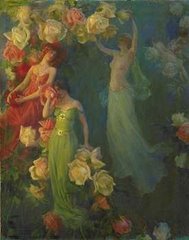
In perfumery we talk about accords like in music you use the term chords. A chord in music is made from different tones but together they sound like a single tone or note because they have a harmony.
It's the same in perfumery; an accord is made of different notes that blend together so well that it's like you smell a single note, the notes that are used lose their individual identity and create a completely new, unified odor impression.
You could also compare it with painting, when you blend the two colors yellow and blue you will not create a yellow/blue color but a complete new color: green. You can't identify the yellow and blue anymore. The same it is with an accord in perfume, these single notes are so well balanced together that you can't identify them anymore together they created a complete new note.
When we say that a perfume has a strong accord we mean that it is build upon notes that harmonise together and smell complete, they 'work' together. The perfume has character and the notes are there for a reason it doesn't smell confusing it's like the perfume couldn't be made on another way.
Accords have mostly just a couple of notes, like 5 or 7 notes but they could have also much more. These notes are combined together in a way that the result smells complete, this accord is the skeleton of the perfume the perfume is based and build around this accord. Than the perfumer starts to add notes in real tiny amounts to complete the perfume, maybe to enhance some notes or to tone down some notes. This process takes a lot of time and patience of the creator.
There are many types of accords like Chypre, Fougere etc Here are some of them:
Ambre accord
Has beside ambernotes also vanilla, cinnamonlike,
spicy, dry fruitlike aspects. Together with balsamic
notes like: Benzoin, Tolu and Labdanum.
Ambrein accord
Bergamot, Vanilla or Vannilin, Coumarine and Civet
makes the Ambrein accord, together with balsamic
notes like Benzoin, Opopanax, Tolu, Labdanum. Mostly
combined with wood and rose notes.
Typical perfumes made of the ambrein accord are
Shalimar, Must de Cartier and Obsession
Chypre
Chypre has a harmony between the freshness of bergamot and the
intense fragrance of oak moss. Mostly combined with roses and
jasmine. The base contains beside the oak moss also patchouli,
cedar and labdanum. Chypre was the name of a perfume made by
coty in 1917. It does not exist anymore but many chypre perfumes
are inspired by it.
An example of a Chypre formula:
Bergamot 15
Sandalwood 8
Vetiver 6
oakmoss 5
Rose 6
Jasmin 5
Gamma Methyl Ionone 3
Patchouli 5
Musk ketone 3
Clary sage 2
Neroli 2
Fougere
Fougere is a type of perfume that has lavender,
patchouli, oak moss and the fragrance of hay from
coumarine, Tonka bean or Hay absolute. In French Fougere means fern.
In 1882 Houbigant made Fougere Royal. The Fougeres
are related to that perfume. Fougere based perfumes
are mostly men perfumes.
Mellis accord
The Mellis accord has Benzyl salicylate,
Eugenol combined with Patchouli, Hydroxycitronellal,
spices, woodnotes and Coumarine together with balsamic notes.
Typical Mellis perfumes are Youth Dew, Opium and Coco Chanel.
There are many more accords and sometimes two or more accords are blended together. Perfumers use these accords that already been found by other perfumers to create complete new accords by adding new or unexpected materials to these accords. Also new accords are still discovered.
Below an example how different notes can create a whole new note where you don't smell the single notes anymore.
Just take these notes, combine them (only in the right proportions)and ...... scroll down to the bottom and see the result
Butter

+
Fresh grass

+
Ripe apples

+
Cotton candy

=
Strawberry


 Chaya who comment her often sent me some samples of wonderful perfumes and Santal de Mysore was one of them. Thank you Chaya! When I first smelled this perfume I was in love.
Chaya who comment her often sent me some samples of wonderful perfumes and Santal de Mysore was one of them. Thank you Chaya! When I first smelled this perfume I was in love.  This perfume is based on the scent of sandalwood, no surprise when you know its name, it has a warm, thick, creamy, woodsy fragrance. The sandalwood in this fragrance is a deep warm sandal sweetened with a caramel note that could be coming from Fenugreek although it's not listed in the ingredients. The top is sweet but has also spicy notes like the note of Cumin and an almost curry like note. This perfume is so soft and warm, not in a timid way but a full warm soft thick perfume, it's like the feeling of soft velvet. It isn't linear though because of the spices that are used in this fragrance. The fragrance plays a game on your skin, one time it will give you a warm caramel note and another time a sandal note, a spicy note or even a green note comes forwarded once in a while.
This perfume is based on the scent of sandalwood, no surprise when you know its name, it has a warm, thick, creamy, woodsy fragrance. The sandalwood in this fragrance is a deep warm sandal sweetened with a caramel note that could be coming from Fenugreek although it's not listed in the ingredients. The top is sweet but has also spicy notes like the note of Cumin and an almost curry like note. This perfume is so soft and warm, not in a timid way but a full warm soft thick perfume, it's like the feeling of soft velvet. It isn't linear though because of the spices that are used in this fragrance. The fragrance plays a game on your skin, one time it will give you a warm caramel note and another time a sandal note, a spicy note or even a green note comes forwarded once in a while.























